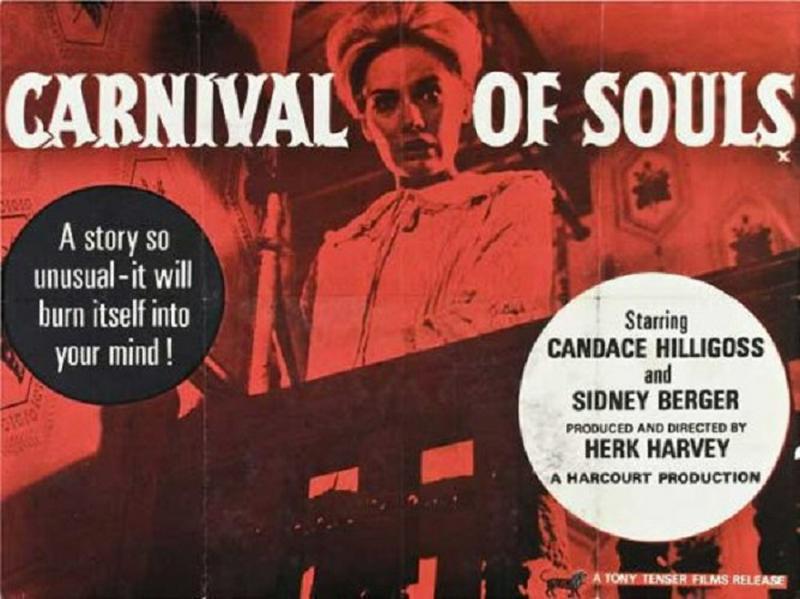Carnival of Souls: Creating Horror On A Low Budget
By | October 26, 2021

In 1961, Herk Harvey was working for Centron, an industrial and educational film company. He was driving home to Lawrence, Kansas, when he stopped to explore the Saltair Pavilion outside Salt Lake City, Utah. The pavilion, which was an abandoned ballroom, inspired Harvey. Later, he called his friend John Clifford, to ask him to write a screenplay based on the pavilion. The only restriction was the final scene, which would feature the ghouls dancing in the ballroom. Within three weeks, Clifford had written Carnival of Souls, the story of Mary Henry (Candace Hilligoss), a survivor of a car accident after a drag race.

Mary Encounters The Pavilion
After the accident, Mary moves to Utah, where she has taken a job playing the organ in a church. During the ride through the desert, her radio will only play organ music and she starts to have visions of a strange, ghoulish man, only called “the Man.” She also glimpses the abandoned pavilion on the shores of the Great Salt Lake, and she learns from a gas station attendant that it had been a bathhouse, then a dancehall, and, before it closed, a carnival. Once in Utah, Mary rents a room in a boarding house, and the proprietor informs her that there is one other boarder. Eventually, Mary meets this other boarder, Mr. Linden (Sidney Berger), a creepy man who is determined to become better acquainted with Mary even after she initially rebuffs him. After unpacking her suitcase, Mary goes to the church where she will be playing the organ. The minister drives her out to get a closer look at the pavilion, and when she is tempted to enter and explore, the minister informs her that it would be illegal.

She Is Haunted By Ghouls
She starts to not only see “the Man” who no one else can see, but she starts to experience interludes when no one can see or hear her; it seems as if she no longer exists. At the church, she starts to practice, and her music shifts from playing a hymn to playing eerie music. When the minister hears her, he denounces the music and insists that she resign. As things continue to crumble around her, she becomes convinced that she has to go to the pavilion. While there, she finds herself surrounded by ghouls, including “the Man,” who becomes her dancing partner. She tries to run away, and the ghouls chase her onto the beach.

It Did Not Require Special Effects To Create Its Horror
Carnival of Souls lacks the special effects of many horror movies but, according to the Time Out film guide, relies on the "striking black-and-white compositions, disorienting dream sequences and eerie atmosphere." These elements, coupled with the organ music, help to create a film that some consider one of the best horror films of the 1960s.

Making Due With Limited Funds
The film cost $33,000 to make, although it started with a budget of only $17,000. Harvey raised that money by asking local businessmen to invest $500 in the film. The remainder of the budget was deferred. Harvey worked with a crew of only five, which helped to keep costs under control. Harvey, who had worked on industrial films, used the techniques he had learned to help cut production costs. He hired an assistant director, Reza Badiyi, an Iranian immigrant who was just starting his career (he would go on to film iconic film and television show openings and montages). The lead actress, Candace Hilligoss, was only paid approximated $2,000 for her performance. He also played the role of “the Man” himself, eliminating the need to hire another actor for the role. Much of the filming was done in Lawrence and he paid just $50 to rent the Saltair Pavilion, using students from the Mormon School of Modern Dance to stage the ballroom scene.

Finding A Second Life
When the film was first released, it was largely unnoticed after its world premier at the Main Street Theatre in Lawrence, Kansas in September 1962. It was marketed as a B movie, and its relatively new distribution company went bankrupt. However, it found its way to late-night television, becoming a bit of a cult classic, and, in 1989, was re-released for arthouse screenings. Carnival of Souls, Herk Harvey’s directorial debut, would be his only feature film, although the understated horror film would be cited as an influence for other filmmakers, including David Lynch and George A. Romero.
